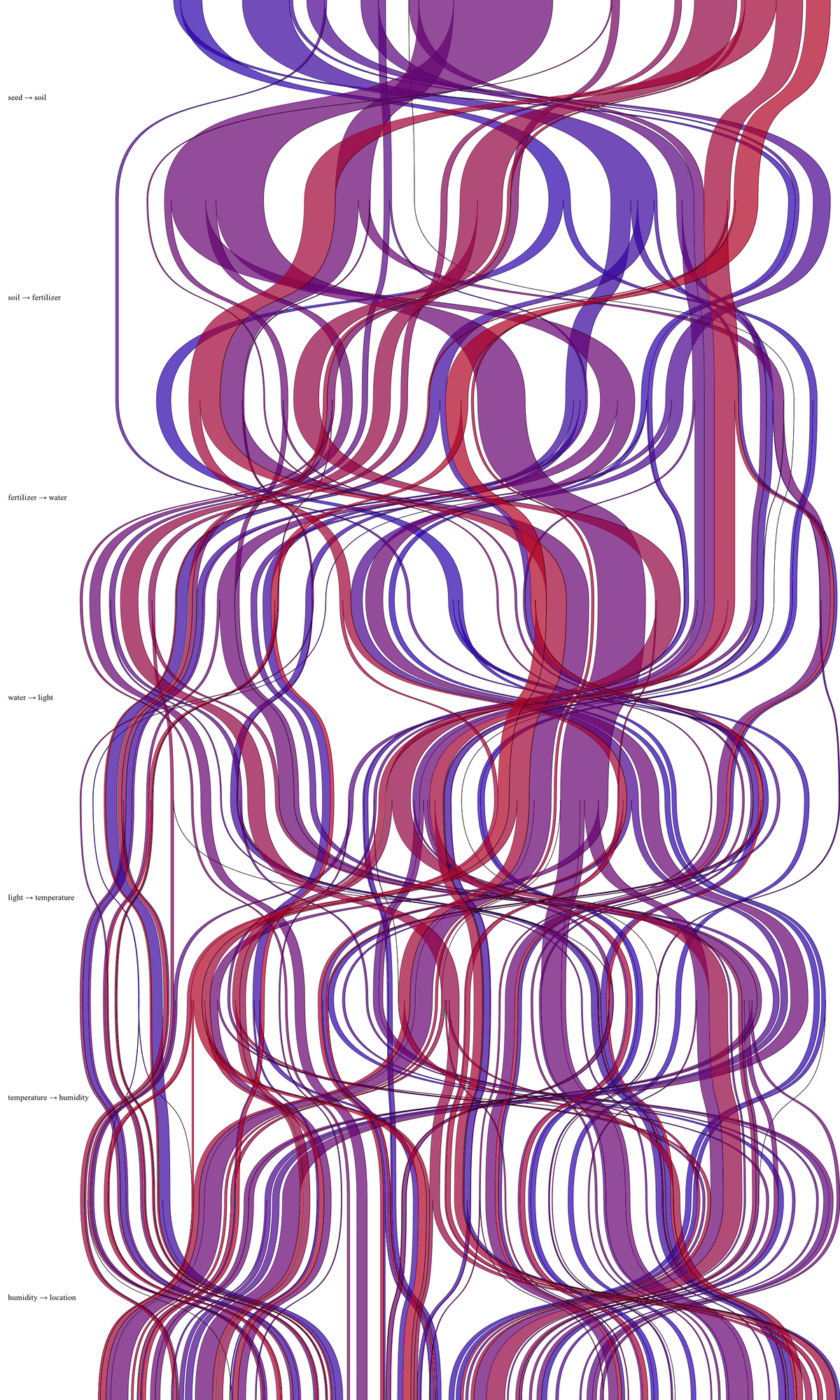I originally didn’t want to write another blog post about Advent of Code, especially not consecutive ones. However, the solution to the second part of the fifth day was so interesting that I couldn’t resist. The puzzle is about mapping intervals to one another.
This puzzle cost me my sanity
I just want to note that this puzzle took my sanity. Never have I had more off-by-one errors or “why the fuck doesn’t this work?” moments.
So let’s get started, shall we?
The puzzle
To understand the puzzle, let’s have a look at the example input from the puzzle:
seeds: 79 14 55 13
seed-to-soil map:
50 98 2
52 50 48
soil-to-fertilizer map:
0 15 37
37 52 2
39 0 15
fertilizer-to-water map:
49 53 8
0 11 42
42 0 7
57 7 4
water-to-light map:
88 18 7
18 25 70
light-to-temperature map:
45 77 23
81 45 19
68 64 13
temperature-to-humidity map:
0 69 1
1 0 69
humidity-to-location map:
60 56 37
56 93 4
Careful
Due to Feedback by one of my more-than-patient friends who proofread the article: In this article we’re only ever dealing with natural numbers. All intervals are natural numbers.
Our input is a list of maps (for example the seed-to-soil map). Each line should be read as
destination source length1. So the source is a seed, the destination is a soil. In other
words, in the example input, we’re given two intervals:
- which maps to , and
- which maps to .
If we have no specific mapping defined, a number just stays the same.
In the first line we’re also given ranges of seed IDs (a start and a length). In the example
input, we need to look at and .
We’re now supposed to use each map in succession to go from our seed IDs to locations. The goal of the puzzle is to find the smallest location number for all given seeds.
Below you can find a cool visualization of the problem by reddit user /u/NullPointerExcept10n2. It shows how ranges of seeds map to different soils, humidities, …, and locations.

Let’s look at this mathematically
We can understand each of these maps as a function like this:
Thus, our goal is — for a given set of seeds — to find3
We can make some immediate observations:
-
We can express our set of seeds as a union of intervals. For any set of seeds we can construct
where is a family of intervals and (the intervals are pairwise disjunct).
-
We can rewrite our functions to make all intervals explicit. We can also change to be a bit more explicit. Instead of just saying ” otherwise”, we can precisely specify under which circumstances maps to itself. For example
We can clearly see that is made up of four different mapping intervals. Let’s call these intervals , where is the corresponding function and their index. We know (because is a function) that these intervals are pairwise disjunct as well.
Let’s keep the intervals well-ordered: if , then and 4.
-
For any given interval , the value of increases monotonically. For example, let’s look at the interval . We can see that and .
This has severe implications. Because we know that within intervals the value is monotonically increasing, we don’t have to look at all values in an interval, we can “short circuit”:
With this in hand, we can start asking the big questions:
What does actually look like?
We already discussed that we can express our functions and as families of intervals and . Thus, asking “what does look like?” is really asking for .
Let’s pick any . We can now look at a new set . What does look like? In the general case
In plain English: consists of a subsets of a subset of ‘s intervals.
Intuitively, this makes sense. We can also see that
So how do we actually find the ?
Implementing the idea
Maybe now is the time to move away from mathematical notation and actually get started coding.
Educational content ahead
The goal of this blog post is to explain the concepts. Some of the code might not be optimal.
Step 1: Fixing the intervals
We start with a list of three-tuples for each map (start, length, destination). We want to now add
the missing intervals like in the “Making intervals explicit” step above.
Implicit precondition
The following code assumes that your input is sorted. Check out the code on GitHub if you get stuck.
def make_intervals_explicit(
mapping: list[tuple[int, int, int]]
) -> list[tuple[int, int]]:
ret = []
for i, (start, length, destination) in enumerate(mapping):
ret.append((start, destination))
# If the next interval is not directly adjacent, we have to insert a new one
# Do this for the last interval in any case
if (i != len(mapping) - 1 and mapping[i + 1][0] != start + length) or (
i == len(mapping) - 1
):
ret.append((start + length, start + length))
# Add a starting interval if mapping didn't start with 0
if ret[0][0] != 0:
ret.insert(0, (0, 0))
return merge_intervals(ret)
This function will for a given function (mapping) return . Another way to think of the output is a list of tuples .
Note that the function also merges intervals if possible:
def merge_intervals(l: list[tuple[int, int]]) -> list[tuple[int, int]]:
# Someone who's better in python than me tell me if we actually need
# this copy
ret = l
i = 1
# Merge intervals if possible
while i < len(ret) - 1:
start, start_value = ret[i]
end, end_value = ret[i + 1]
if start_value + (end - start) == end_value:
del ret[i + 1]
i += 1
return ret
Sidenote
It might be nice to use a Python generator for that (with a yield expression).
Step 2: Calculating all intersecting intervals
As a next step, we can get started calculating for an interval to find all intervals it intersects. This is the step where we calculate .
def get_intersected_intervals(
start: int, end: int | None, mapping: list[tuple[int, int]]
) -> list[tuple[int, int]]:
ret = [
value
for value in mapping
if start <= value[0] and (end is None or end >= value[0])
]
# We need to fill the interval from the left
if len(ret) == 0 or ret[0][0] > start:
start_index = bisect.bisect_left(mapping, (start,)) - 1
x, f_x = mapping[start_index]
ret.insert(0, (start, f_x + (start - x)))
return ret
First, we get all intervals that start within start and end ( earlier). This covers our
entire interval except for the first part: For that we need to take the previous interval
(the one that starts before start) and clamp it so it starts at start. We use Python’s bisect
module to find the intervals that start before
start.
Step 3: Calculating
We can now get started calculating the function composition. We discussed that . We also know that we can get from get_intersected_intervals().
def compose(
f: list[tuple[int, int]], g: list[tuple[int, int]]
) -> list[tuple[int, int]]:
ret = []
for (x_start, f_start), (x_end, _) in zip(f, f[1:]):
length = x_end - x_start
ret.extend(
[
(start - (f_start - x_start), projection)
for start, projection in get_intersected_intervals(
f_start, f_start + length, g
)
]
)
f_start = f[-1][1]
ret.extend(
[
(start, projection)
for start, projection in get_intersected_intervals(f_start, None, g)
]
)
return ret
We use Python’s zip method5 to get our intervals . As a last step, we add the last
interval back.
Step 4: Lookup
To solve the puzzle, we finally need a function lookup that actually uses one of these maps to
find the value. The input to this function are the from earlier. Here’s the code:
def lookup(start: int, end: int, f: list[tuple[int, int]]):
values = [mapping for _, mapping in get_intersected_intervals(start, end, f)]
return min(values)
Here we use the short-circuiting we discussed earlier: get_intersected_intervals will return the
starting points for each interval. Because the intervals are strictly monotonic, we never want to
evaluate beyond their starting point. Hence, it is sufficient to just take the minimum of each
starting point’s value.
Step 5: Profit!
With all this set-up, we can finally calculate our entire function composition.
First, we set up our maps:
seed_to_soil_map = make_intervals_explicit(
parse_map(_seed_to_soil.splitlines()[1:])
)
soil_to_fertilizer_map = make_intervals_explicit(
parse_map(_soil_to_fertilizer.splitlines()[1:])
)
fertilizer_to_water_map = make_intervals_explicit(
parse_map(_fertilizer_to_water.splitlines()[1:])
)
water_to_light_map = make_intervals_explicit(
parse_map(_water_to_light.splitlines()[1:])
)
light_to_temp_map = make_intervals_explicit(
parse_map(_light_to_temp.splitlines()[1:])
)
temp_to_humidity_map = make_intervals_explicit(
parse_map(_temp_to_humidity.splitlines()[1:])
)
humidity_to_location_map = make_intervals_explicit(
parse_map(_humidity_to_location.splitlines()[1:])
)
We then combine them into one complete map:
total_map = reduce(compose, [
seed_to_soil_map,
soil_to_fertilizer_map,
fertilizer_to_water_map,
water_to_light_map,
light_to_temp_map,
temp_to_humidity_map,
humidity_to_location_map,
])
Because we’re fancy, we use functool’s
reduce instead of writing it
out. reduce applies compose cumulatively from left to right to the items of sequence.
Finally, the solution of the puzzle (find the smallest location for ranges of seeds) can be found by
values_part2 = [
lookup(start, start + length, total_map)
for start, length in zip(seeds[::2], seeds[1::2])
]
print(f"Part 2: {min(values_part2)}")
Footnotes
-
Not my fault they decided on doing it this way. Each time I read the input I get confused as well. ↩
-
Thanks again for letting me use it in my blog! ↩
-
"" denotes function composition (e.g. means ). ↩
-
This is a bit imprecise, because if or , we apply 0 or as the borders respectively, but the idea is still the same. ↩
-
This code uses some pythonic pattern, which is to call
zip()with the same list. The idea is to generate pairs of adjacent items from the list. This StackOverflow Answer has more information. ↩
